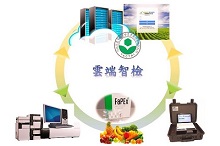Stories
Posted date
2018.08.15Taiwan Agricultural Chemicals and Toxic Substances Research Institute

Blue background
Taiwan Agricultural Chemicals and Toxic Substances Research Institute (TACTRI) was established in January 1st, 1985. TACTRI arose from the previous Taiwan Plant Protection Center (TPPC) that was cofounded by United Nations Development Program and Republic of China (ROC) government in 1971. Since ROC withdrawal from UN, TPPC was completely funded by ROC government. In 1985, in efforts to recognize the research achievements in safe and minimal use of pesticides, the Center was transformed into TACTRI, a governmental research institute under the subjection of Provincial Department of Agriculture and Forestry (PDAF). After readjustment of government structure and function in 1999, TACTRI was under the subjection of the Council of Agriculture, Executive Yuan.
TACTRI is responsible for pesticide research and development, the monitor of pesticide residues and toxic substances in agricultural products, plant protection technology development, pesticide technical services, and the establishment of analytical methods and evaluation standards to ensure pesticide rational usage and the safety of agricultural products.
The aims of TACTRI are as following:
1. Provide pesticide regulatory authorities with technical support in pesticide management, registration, and quality regulation.
2. Support industry regulatory authorities in monitoring agricultural products and aquatic products for food safety and ensure the functionality of monitoring system as well as provide technical advices.
3. Improve production technologies of plant protective products to improve pesticide quality, develop pesticide formulations to pursue lower production cost, and strengthen the pesticide safety evaluation.
4. Develop novel plant protection methods for safe, economic and rational usage in pesticides application.
The organizational structure of TACTRI consists of five divisions: Residue Control Division, Risk Assessment Division, Product Development Division, Crop Protection Division, and Technical Service Division. Technical Service Division works to integrate research findings and provide technical information of the other four divisions.
The main works of the five divisions are displayed in the following:
The main works of the Residue Control Division are monitoring pesticide residues and heavy metals in agricultural commodities and field environments. Monitoring data can be further applied in safety assessment and rational pesticide usage evaluation to prevent pesticide and heavy metal residue hazards. The inspection center under the division works to provide service in the inspection of pesticide residue, heavy metals, and dioxins in crops, animal products, and processed products. The inspection center is also responsible for the inspection of pesticide specification for farmer safety and reliability towards pesticide usages.
The main works of the Product Development Division develops plant protective materials that are environmentally friendly in aim to substitute conventional pesticides. These environmentally friendly materials are non- or low-toxic biopesticides and chemical materials, including microbials with insecticidal, fungicidal, herbicidal, and multi-functions and safe pesticide formulations.The division has successfully developed several indigenous microbial products, including Bacillus thuringiensis subsp. kurstaki and Bt aizawai which are insecticidal, Bacillus amyloliquefaciens with multiple functions, entomogenous fungi, and microbial herbicides. Several male insect attractants are also developed into semiochemical products. In addition, the division has also established several quality control techniques and physicochemical test systems that comply with Good Laboratory Practice (GLP). These developments received domestic and foreign patents as well as authorization rights on product production and quality control techniques.
To ensure the effectiveness of these developed materials and to apply them under safe and economic conditions, safe materials application techniques in integrated pest management (IPM) are also included in our studies, providing various effective materials to extend the usage of safety materials in fields.
The main works of the Risk Assessment Division is to study and evaluate the effect of pesticides and toxic substances on human health, animal health, and the environment. To facilitate in pesticide regulation and plant protection for ensuring safe and rational pesticide usage, the division performs risk assessment on pesticides and toxic substances as well as strategic analysis on risk management, development of safety assessment test techniques, and its regulatory quality standards. In 1996, the division established a specific pathogen-free (SPF) animal house to support animal toxicological testing. In March 2010, the accreditation of GLP Laboratory was obtained in testing of animal toxicology, mutagenicity, aquatic and terrestrial environmental toxicology, and rodenticide. The GLP laboratories support pesticide companies in toxicology testing required for pesticide registration. Testing and diagnose techniques of necropsy method, histopathological examination, processing of tissues and specimens, and light/electron microscopy photography are developed to provide evidence for toxicity or clinical signs. Mode of action of toxic substances is investigated and its effect to endocrine and hormones are studied to evaluate its potential hazards on humans. Furthermore, the division works in rodenticide testing for rodent prevention and control, risk assessment for gene-modified crops and pathogen contamination on agricultural products, development of microbial origin herbicide and its safety evaluation, setting reference dose value (RfD, also known as acceptable daily intake (ADI)) for the establishment of maximum residue limits (MRLs) and pre-harvest intervals (PHIs).
The main tasks of Crop Protection Division are (i) to investigate the norm of pesticide rational usage in fields, (ii) to study the efficacy and toxicity of insecticides, fungicides, and herbicides, and (iii) to improve pest control measures to establish integrated pest control strategies. The division has four laboratories for the following studies: herbicides and their efficacy and toxicology, toxicity and resistance of pesticides (fungicides, insecticides, and acaricides), integrated pest management,detection and monitoring of plant pests.
Besides executing the research plans, we offer the services including toxicology testing services, microbial pest control agent, physical and chemical properties testing services, summary of requirements for pesticide registration and declare lately the common name of new pesticide.